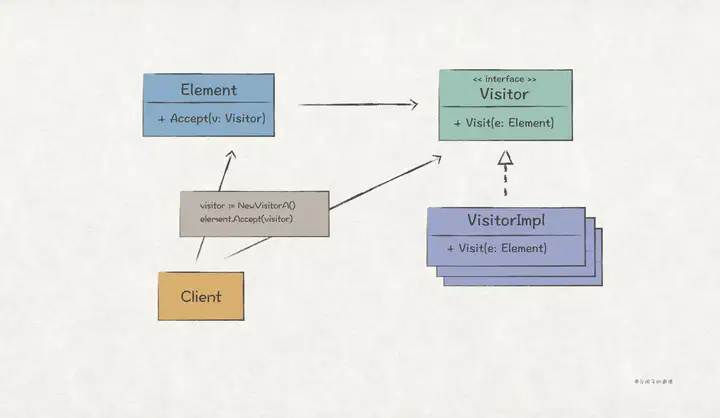摘要:访问者模式的目的是,解耦数据结构和算法,使得系统能够在不改变现有代码结构的基础上,为对象新增一种新的操作。
本文分享自华为云社区《【Go实现】实践GoF的23种设计模式:访问者模式》,作者:元闰子 。
简介
GoF 对访问者模式(Visitor Pattern)的定义如下:
Represent an operation to be performed on the elements of an object structure. Visitor lets you define a new operation without changing the classes of the elements on which it operates.
访问者模式的目的是,解耦数据结构和算法,使得系统能够在不改变现有代码结构的基础上,为对象新增一种新的操作。
上一篇介绍的迭代器模式也做到了数据结构和算法的解耦,不过它专注于遍历算法。访问者模式,则在遍历的同时,将操作作用到数据结构上,一个常见的应用场景是语法树的解析。
UML 结构

场景上下文
在 简单的分布式应用系统(示例代码工程)中,db 模块用来存储服务注册和监控信息,它是一个 key-value 数据库。另外,我们给 db 模块抽象出 Table 对象:
// demo/db/table.go package db // Table 数据表定义 type Table struct { name string metadata map[string]int // key为属性名,value属性值的索引, 对应到record上存储 records map[interface{}]record iteratorFactory TableIteratorFactory // 默认使用随机迭代器 }
目的是提供类似于关系型数据库的按列查询能力,比如:

上述的按列查询只是等值比较,未来还可能会实现正则表达式匹配等方式,因此我们需要设计出可供未来扩展的接口。这种场景,使用访问者模式正合适。
代码实现
// demo/db/table_visitor.go package db // 关键点1: 定义表查询的访问者抽象接口,允许后续扩展查询方式 type TableVisitor interface { // 关键点2: Visit方法以Element作为入参,这里的Element为Table对象 Visit(table *Table) ([]interface{}, error) } // 关键点3: 定义Visitor抽象接口的实现对象,这里FieldEqVisitor实现按列等值查询逻辑 type FieldEqVisitor struct { field string value interface{} } // 关键点4: 为FieldEqVisitor定义Visit方法,实现具体的等值查询逻辑 func (f *FieldEqVisitor) Visit(table *Table) ([]interface{}, error) { result := make([]interface{}, 0) idx, ok := table.metadata[f.field] if !ok { return nil, ErrRecordNotFound } for _, r := range table.records { if reflect.DeepEqual(r.values[idx], f.value) { result = append(result, r) } } if len(result) == 0 { return nil, ErrRecordNotFound } return result, nil } func NewFieldEqVisitor(field string, value interface{}) *FieldEqVisitor { return &FieldEqVisitor{ field: field, value: value, } } // demo/db/table.go package db type Table struct {...} // 关键点5: 为Element定义Accept方法,入参为Visitor接口 func (t *Table) Accept(visitor TableVisitor) ([]interface{}, error) { return visitor.Visit(t) }
客户端可以这么使用:
func client() { table := NewTable("testRegion").WithType(reflect.TypeOf(new(testRegion))) table.Insert(1, &testRegion{Id: 1, Name: "beijing"}) table.Insert(2, &testRegion{Id: 2, Name: "beijing"}) table.Insert(3, &testRegion{Id: 3, Name: "guangdong"}) visitor := NewFieldEqVisitor("name", "beijing") result, err := table.Accept(visitor) if err != nil { t.Error(err) } if len(result) != 2 { t.Errorf("visit failed, want 2, got %d", len(result)) } }
总结实现访问者模式的几个关键点:
- 定义访问者抽象接口,上述例子为 TableVisitor, 目的是允许后续扩展表查询方式。
- 访问者抽象接口中,Visit 方法以 Element 作为入参,上述例子中, Element 为 Table 对象。
- 为 Visitor 抽象接口定义具体的实现对象,上述例子为 FieldEqVisitor。
- 在访问者的 Visit 方法中实现具体的业务逻辑,上述例子中 FieldEqVisitor.Visit(...) 实现了按列等值查询逻辑。
- 在被访问者 Element 中定义 Accept 方法,以访问者 Visitor 作为入参。上述例子中为 Table.Accept(...) 方法。
扩展
Go 风格实现
上述实现是典型的面向对象风格,下面以 Go 风格重新实现访问者模式:
// demo/db/table_visitor_func.go package db // 关键点1: 定义一个访问者函数类型 type TableVisitorFunc func(table *Table) ([]interface{}, error) // 关键点2: 定义工厂方法,工厂方法返回的是一个访问者函数,实现了具体的访问逻辑 func NewFieldEqVisitorFunc(field string, value interface{}) TableVisitorFunc { return func(table *Table) ([]interface{}, error) { result := make([]interface{}, 0) idx, ok := table.metadata[field] if !